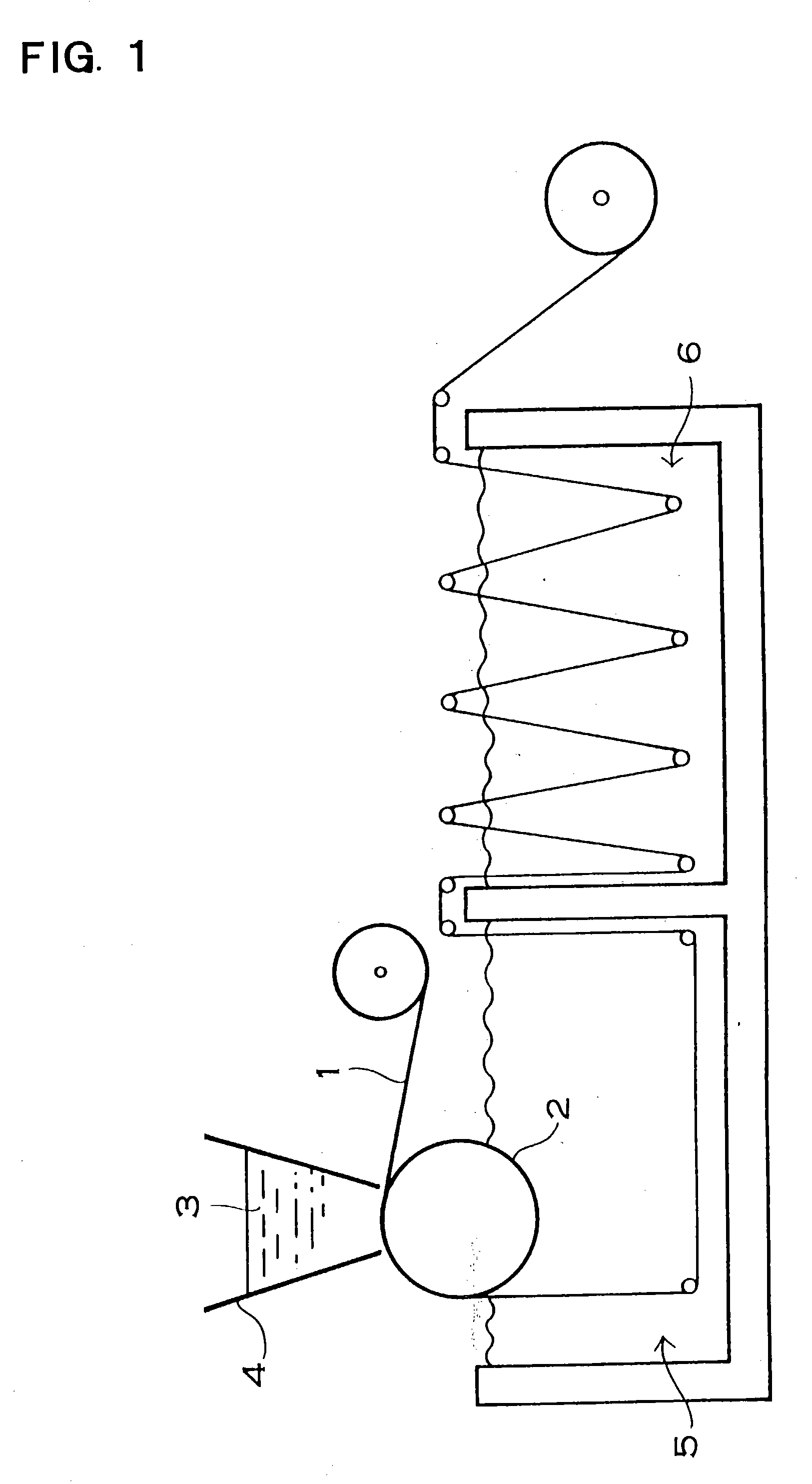Laminated material of segregating membrane and segregating membrane supporting material, and its method of manufacture
a technology of segregating membrane and supporting material, which is applied in the field of laminate materials, can solve the problems of reduced adhering strength, decreased uniformity of segregating membrane supporting material, and degraded anchoring effect responsible for adhesion of segregating membrane to supporting material, etc., and achieves uniform segregating membrane, adhesion strength, and adhesion strength.
- Summary
- Abstract
- Description
- Claims
- Application Information
AI Technical Summary
Benefits of technology
Problems solved by technology
Method used
Image
Examples
embodiments
[Embodiment 1]
[0032] The laminated material of a segregating membrane and a segregating membrane supporting material of the present invention is fabricated by the following method.
(1) Non-Woven Fabric Forming Step
[0033] Non-woven fabric is made by wet processing methods 40% by weight polyacrylonitrile-based synthetic fiber, and 60% by weight polyester fiber are used to form the non-woven fabric. Average length of the polyacrylonitrile-based synthetic fiber is 5 mm. Polyester fibers are mixed as 20% by weight primary fiber and 40% by weight binder fiber. Un-extended polyester fiber is used as binder fiber. Primary fiber is a mixture of the same weight of diameter of 12.4 μm fibers and diameter of 17.5 μm fibers. Binder fiber size is diameter of 10.1 μm. The density of polyester fibers is 1.39 g / cm3, and the density of polyacrylonitrile-based synthetic fibers is 1.15 g / cm3.
[0034] In the wet processing of the non-woven fabric, paper producing machines already in use for wet proces...
embodiment 2
[Embodiment 2]
[0041] Fibers comprising the non-woven fabric are 10% by weight polyacrylonitrile-based synthetic fiber, 90% by weight polyester fiber, polyester fibers are 50% by weight primary fiber and 40% by weight binder fiber. Other than this fiber content, segregating membrane supporting material is produced in the same manner as embodiment 1, and its properties are listed in Table 1. The same polyacrylonitrile-based synthetic fibers and polyester fibers as used in embodiment 1 are used here.
[0042] This segregating membrane supporting material has a thickness of 103 μm, bulk density of 0.730 g / cm3, vertical tensile strength (MD) of 6.98 kg / 15 mm, horizontal tensile strength (CD) of 4.15 kg / 15 mm, bursting strength of 4.8 kg / cm2, permeability of 6.32 cm3 / cm2 / sec, and overall bulk density equal to 53% of the density of the fibers comprising the non-woven fabric.
[0043] When a segregating membrane is formed as a laminate on the segregating membrane supporting material in the same...
embodiment 3
[Embodiment 3]
[0044] Fibers comprising the non-woven fabric are 80% by weight polyacrylonitrile-based synthetic fiber, 20% by weight polyester fiber, and all polyester fibers are binder fibers. Other than, this fiber content, segregating membrane supporting material is produced in the same manner as embodiment 1, and its properties are listed in Table 1. The same polyacrylonitrile-based synthetic fibers and polyester fibers as used in embodiment 1 are used here.
[0045] This segregating membrane supporting material has a thickness of 120 μm, bulk density of 0.613 g / cm3, vertical tensile strength (MD) of 6.55 kg / 15 mm, horizontal tensile strength (CD) of 3.56 kg / 15 mm, bursting strength of 3.4 kg / cm2, permeability of 6.56 cm3 / cm2 / sec, and overall bulk density equal to 51% of the density of the fibers comprising the non-woven fabric.
[0046] When a segregating membrane is formed as a laminate on the segregating membrane supporting material in the same manner as embodiment 1, its adhesio...
PUM
| Property | Measurement | Unit |
|---|---|---|
| Length | aaaaa | aaaaa |
| Length | aaaaa | aaaaa |
| Fraction | aaaaa | aaaaa |
Abstract
Description
Claims
Application Information
 Login to View More
Login to View More - R&D
- Intellectual Property
- Life Sciences
- Materials
- Tech Scout
- Unparalleled Data Quality
- Higher Quality Content
- 60% Fewer Hallucinations
Browse by: Latest US Patents, China's latest patents, Technical Efficacy Thesaurus, Application Domain, Technology Topic, Popular Technical Reports.
© 2025 PatSnap. All rights reserved.Legal|Privacy policy|Modern Slavery Act Transparency Statement|Sitemap|About US| Contact US: help@patsnap.com

